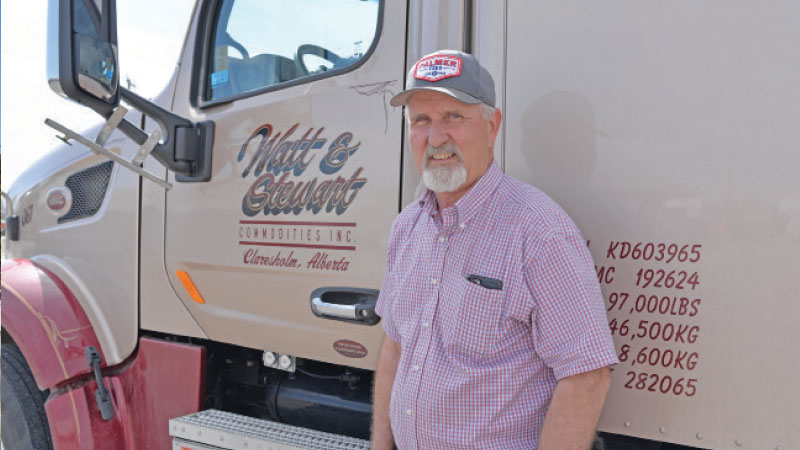By the BC Trucking Association
In the quest to end climate change, Canada has joined more than one hundred countries around the world in the commitment to achieve net-zero emissions by 2050.
This global initiative is an ambitious one, and reducing emissions generated by the commercial road transportation industry will be essential to Canada achieving its goal. The transportation sector is the second highest source of greenhouse gas (GHG) emissions in Canada and freight is the fastest growing segment of that sector.1
Although the transition to net zero will not be an easy one for our industry, taking advantage of emission-reducing technologies and solutions is crucial to reaching the 2050 target. In fact, nearly two-thirds of GHG emissions reductions by 2030 would rely on solutions that are already commercially available.2 Over 90% of all consumer goods are transported by a truck, and the population in BC alone is expected to grow by 1.38 million by 2041.3 The economy’s reliance on our industry is set to grow, which is why the BC Trucking Association (BCTA) is committed to its environmental stewardship efforts: to advocate for outreach and incentives, specific to carriers, to adopt fuel efficiency technology and practices. The BCTA is confident that there will be a vast improvement on the reduction of GHG emissions in future years as the industry learns about and invests in technology that has reliable and documented results in reducing fuel usage and emissions.
“We are proud of how the BC trucking industry is embracing environmental sustainability and showing its support for the reduction of GHG emissions,” said Dave Earle, BCTA President and CEO. “The BCTA team is working diligently with our members to identify options for fuel efficiency, and more importantly opportunities to adopt this technology. By doing so, fleets will not only be doing the right thing, but they’ll also be creating long-term value by experiencing an ROI on their fuel saving technology and being ahead of the curve on environmental regulations.”
The Cold, Hard Math
Our industry’s commitment to reduce GHG emissions will be challenged by the objective realities that currently exist. While zero emission vehicles (ZEVs) are on the very near horizon, the cold truth is that numbers work against us in meeting our collective reduction targets.
GHG emissions are tracked at a medium and heavy-duty (MHD) vehicle level for our sector. Data from the Insurance Corporation of British Columbia (ICBC) shows there are about 216,000 such vehicles licenced in BC with the average model year being 2009.
Approximately 60,000 of those vehicles are heavy trucks (11,794 kg plus) with an average model year of 2008. The same data tells us that fleet turnover is 2.9% and a heavy fleet grows by 1% per year. Simply put, in the current environment, we have an opportunity to turn over roughly 4% of heavy vehicles registered in BC every year.4
By 2030, we expect to see nearly 66,000 heavy trucks licenced in BC.
To meet our target of a 40 to 45% GHG reduction, nearly 20,000 heavy trucks in BC would have to be zero emission. At a 4% fleet conversion opportunity, to meet our 2030 target by ZEV deployment alone, every single heavy truck sold in
BC would have to be zero emission starting today.
BC is among the leaders in Canada when it comes to sales of zero emission vehicles in the light fleet. By the end of 2020, over 10% of all new car sales in BC were zero emission and yet 12 years on from the first such sale in 2008, ZEV light vehicle fleet penetration is 1.16%. If our industry aggressively adopts ZEV technology at a pace twice as quickly as the light vehicle fleet, we will still fall woefully short of our emission targets if we were to rely solely on ZEVs to reduce our carbon footprint. This is assuming that these vehicles are readily and reasonably available in the marketplace.
Now that the Canadian Net-Zero Emissions Accountability Act has called on the industry for prompt action to reduce its carbon impact, BCTA has taken on initiatives that will help address some of the emission reduction challenges that we currently face and help transition our industry to a net zero emissions future.
Raising Awareness on Zero Emission Commercial Vehicles
Educating members on zero emission technology is a key component of BCTA’s environmental stewardship initiatives. On April 27, 2021, the BCTA hosted the webinar, The Future of Zero Emission Commercial Vehicles, that provided an overview of our sector’s GHG emission trends. A number of original equipment manufacturers – including Daimler, Kenworth, Lion Electric, MACK, Peterbilt and Volvo – enlightened attendees on their available ZEVs and what
is coming down the line.
Over 160 BCTA members and government officials were in attendance to learn more about ZEV technology and gain insight on how to shape future climate action policy that will help the industry with the zero-carbon transition.
Doug Sutherland, President of Sutco Transportation Specialists, attended the webinar and feels that collaboration among industry, stakeholders and policy makers is needed now more than ever to drive the innovation in transportation required to help us reach our carbon emission goals.
“BCTA’s ZEV webinar was very informational for an organization like ours interested in adopting zero emission commercial vehicles into our fleet,” said Sutherland. “Having six major OEMs present their ZEVs with the opportunity to ask questions was incredibly helpful. Like so many of us, BCTA recognizes that this is a very important conversation to be having, especially given our progress to-date towards our emissions-reduction targets. Our industry can transition to a zero-carbon future, but only with the right policy, incentives, and infrastructure in place. We can’t do it alone.”
While deployment of battery electric units for return to base and regional lanes is imminent, it is limited by range concerns, operating temperature considerations and BC’s mountainous terrain. Assuming no friction and parasitic or temperature-based efficiency losses, the energy required move a 40,000-kilogram load up the 1,200-metre elevation gain from Hope to the Coquihalla Summit alone is 130kw/hr. This is nearly the entire battery capacity of two Tesla Model 3s.
Hydrogen is the most plentiful element in our universe but is invariably affectionate, bonding with other elements and is not found elementally in nature. Breaking this elemental bond requires energy which, in turn, creates GHG emissions of its own by varying degree. The colour of hydrogen matters – green (sourced from entirely renewable energy resources), blue (where the production results in GHG emissions that are carbon-sequestered) or grey (where the production results in GHG emissions) – can result in net GHG emission reductions of 90% or an increase in net GHG emissions. We must get the hydrogen to where it needs to be.
Despite these challenges, the future looks bright as more and more equipment manufacturers race to bring zero emission solutions to markets around the world. Incentives, infrastructure investments and commitment from our customers will help but we need to do more with what we have. Relying on ZEVs alone will not help us reach our emission targets.
Fuel efficiency and commensurate GHG reduction improvements have taken hold in the diesel power environment, with greater than 15% efficiency gains over historical levels common for model year 2020 and newer equipment. Adoption of compressed or liquefied natural gas fuel systems, where practical, can reduce GHG emissions by up to 30% when sourced from traditional sources, and up to 90% for renewable natural gas. Incentives supporting infrastructure, conversion and purchase of new natural gas fueled equipment help, but after
10 years on the market there are still under 1,000 such vehicles licenced in BC.
Effective use of telematics and fuel management programs can have significant impacts on consumption. Installation of auxiliary power units or turnouts of APUs to alternate power (i.e. shore or solar) reduce idling time by hundreds of hours per year. Wide based single tires can decrease fuel consumption by 3 to 7%. Aerodynamic assist devices such as skirts, aero-bumpers and boat tails (or trailer tails) improve fuel-efficiency incrementally.
Incentives to Improve Fuel Efficiency
Since the primary source of emissions (and one of the highest costs) for the transportation industry is diesel, there has been an increased focus on fuel economy that has led to the development of new technologies and practices to reduce fuel consumption.5
For two consecutive years, the BCTA has administered the Province of British Columbia’s highly successful CleanBC Heavy-duty Vehicle Efficiency (HDVE) Program. By providing fuel management strategies and incentives to help BC fleets purchase fuel-efficiency equipment, the cumulative impact of the program has removed 20.5 ktCO2e emissions provincially, and 41.5 ktCO2e emissions across North America. This is equivalent to removing over 4,500 passenger vehicles from BC and 8,800 passenger vehicles across North America.
The purpose of the HDVE program is to show BC-based carriers how to reduce their carbon impact by adopting efficient driving practices, which can reduce fuel consumption and associated GHG emissions by as much as 35%. The program also encourages carriers to adopt GHG emissions-reducing technology for related reductions of as much as 30%.
Pardeep Arora, Director of Triple Eight Transport Inc., participated in the program and was able to cut operating expenses and decrease their carbon footprint through the fuel saving equipment purchased with help of program funding.
“Thanks to the CleanBC HDVE Program, we were able to outfit our tractors with clean, electric auxiliary power units that have cut idling emissions from our trucks in half,” said Arora. “We’re pleased we’ve reduced our fuel usage and costs while still keeping our drivers comfortable in their vehicles.”6
The commitment and interest from the industry is growing exponentially. Year two of the Program received more than double the applications and incentive requests over Year one, at a massive $3.26 million over 85 applications. To date, the Province of British Columbia has committed $2.4 million to the Program.
“Our government is pleased to continue supporting the CleanBC Heavy-duty
Vehicle Efficiency Program in partnership with the BC Trucking Association,” said Claire Trevena, former Minister of Transportation and Infrastructure. “This program is designed to teach participants how to develop a fuel management program that will reduce operating costs associated with fuel. I encourage people in this sector to sign up for this opportunity that will help save money and reduce greenhouse gas emissions.”7
Following the immense success and increase in demand of incentives for Year two, BCTA is hopeful that they can announce Year three of the CleanBC HDVE Program in the near future.
The Road Ahead
As we head towards the global 2050 net zero emissions goal, BCTA is committed to providing information, resources, and opportunities to support our industry’s transition to clean energy. To ensure we meet emission targets for 2030, 2040, and 2050, we must continue to reduce the barriers to adopting ZEVs in the transportation sector. Insufficient charging infrastructure, high upfront purchase price, and inadequate ZEV supply are just some of the obstacles that require targeted policy action to help get our industry on the right path to reach net zero.8
Although there may be significant gaps yet to be filled to accommodate a completely carbon-free future, we can take action today by implementing fuel efficiency practices and technologies that can generate notable reductions in GHG emissions. Collectively we will make a difference, and the trucking industry will emerge stronger, more resilient, and ready for the future.
References
1 Bora Plumptre, Eli Angen, Dianne Zimmerman. The State of Freight (Pembina Institute, 2017). www.pembina.org/reports/state-of-freight-report.pdf
2 Canada’s Net Zero Future (The Canadian Institute for Climate Choices, February 2021). www.climatechoices.ca/wp-content/uploads/2021/02/Canadas-Net-Zero-Future_Summary_FINAL.pdf
3 Transport Canada, 2019. Transportation in Canada 2019: Statistical Addendum. Table EC4. www.tc.canada.ca/en/corporate-services/transparency/corporate-management-reporting/transportation-canada-annual-reports/transportation-canada-2019; Frank IP & Sebastien Lavoie. PEOPLE 2020: BC Sub-Provincial Population Projections (The Government of British Columbia, October 2019). www2.gov.bc.ca/assets/gov/data/statistics/people-population-community/population/people_population_projections_highlights.pdf
4 ICBC Statistics. www.icbc.com/about-icbc/newsroom/Pages/Statistics.aspx (July 2020)
5 Brandon Schoettle, Michael Sivak, Michael Tunnel. A Survey of Fuel Economy and Fuel Usage by Heavy-Duty Truck Fleets (October 2016). www.truckingresearch.org/wp-content/uploads/2016/10/2016.ATRI-UMTRI.FuelEconomyReport.Final_.pdf
6 BCTA Media Release. Registration open for second round of CleanBC Heavy-duty Vehicle Efficiency Program that helps reduce operating costs (September 17, 2020). www.bctrucking.com/media_releases
7 BCTA Media Release. Registration open for second round of CleanBC Heavy-duty Vehicle Efficiency Program that helps reduce operating costs (September 17, 2020). www.bctrucking.com/media_releases
8 Cedric Smith. Reducing barriers for the adoption of light-duty zero-emission vehicles (Pembina Institute, December 2020). www.pembina.org/pub/reducing-barriers-adoption-light-duty-zero-emission-vehicles


 1-866-985-9791
1-866-985-9791



